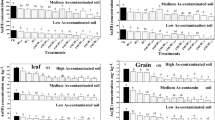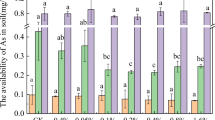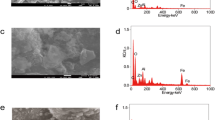Abstract
Arsenic (As) is a prominent metal contaminant of the soil in China. Pot experiments were conducted to examine the effects of corn stem powder biochar (BC) and Fe-Mn-La-impregnated biochar composites (FMLBC1, FMLBC2, and FMLBC3; BC:Fe:Mn:La at different weight ratios) on As accumulation in an indica cultivar of rice (Oryza sativa L.). The application of FMLBCs and BC improved the dry weight of the grains, leaves, stems, and roots of rice. The As uptake in different rice organs was significantly reduced in the FMLBC-amended soils (FMLBC3 > FMLBC2 > FMLBC1) compared with the BC treatment. Compared to the concentration of As in the control, the concentration of As in rice grains decreased by 56.0–89.4% with the addition of 2% FMLBC3. The application of FMLBCs significantly increased the ratio of essential amino acids in grains and the contents of Fe and Mn plaques on root surfaces. The reduction in As accumulation can be ascribed to the Fe, Mn, and La oxides that enhance the adsorption and retention of As, as well as the FMLBCs that provide nutrients and create a rhizosphere environment, promoting rice growth. This study demonstrated that applications of 2% FMLBC2 and FMLBC3 have the potential to remediate As-contaminated soils, reduce As accumulation in rice plants, and improve rice grain quality.



Similar content being viewed by others
References
Ai-Lati A, Liu S, Li X, Qian B, Shan Y, Zhou Z et al (2018) Effect of Chinese rice wine sludge on the production of Chinese steamed buns. J. Food Process. Pres 42(4):13572
Alloway BJ (2013) Sources of heavy metals and metalloids in soils, heavy metals in soils. Springer, pp 11–50
Beesley L, Moreno-Jimenez E, Gomez-Eyles JL, Harris E, Robinson B, Sizmur T (2011) A review of biochars’ potential role in the remediation, revegetation and restoration of contaminated soils. Environ Pollut 159(12):3269–3282
Deng D, Wu SC, Wu FY, Deng H, Wong MH (2010) Effects of root anatomy and Fe plaque on arsenic uptake by rice seedlings grown in solution culture. Environ Pollut 158(8):2589–2595
Dwivedi S, Tripathi RD, Tripathi P, Kumar A, Dave R, Mishra S, Singh R, Sharma D, Rai UN, Chakrabarty D (2010) Arsenate exposure affects amino acids, mineral nutrient status and antioxidants in rice (Oryza sativa L.) genotypes. Environ Sci Technol 44:9542–9549
Ehlert K, Mikutta C, Kretzschmar R (2014) Impact of birnessite on arsenic and iron speciation during microbial reduction of arsenic-bearing ferrihydrite. Environ Sci Technol 48:11320–11329
Fang J, Zhan L, Ok YS, Gao B (2018) Minireview of potential applications of hydrochar derived from hydrothermal carbonization of biomass. J Ind Eng Chem 57:15–21
Han X, Li YL, Gu JD (2011) Oxidation of As(III) by MnO2 in the absence and presence of Fe(II) under acidic conditions. Geochim Cosmochim Acta 75:368–379
Hu Y, Zhou L, Li X, Xu F, Wang L, Mo D, Zhou L, Wang X, Wang X (2015) Arsenic contamination in Shimen Realgar mine I: As spatial distribution, chemical fractionations and leaching. J Agro-Environ Sci 34:7
Ippolito J, Ducey T, Cantrell K, Novak J, Lentz R (2016) Designer, acidic biochar influences calcareous soil characteristics. Chemosphere 142:184–191
Jais FM, Ibrahim S, Yoon Y, Min J (2016) Enhanced arsenate removal by lanthanum and nano-magnetite composite incorporated palm shell waste-based activated carbon. Sep Purif Technol 169:93–102
Kumpiene J, Lagerkvist A, Maurice C (2008) Stabilization of As, Cr, Cu, Pb and Znin soil using amendments-A review. Waste Manag 28:215–225
Li B, Zhou S, Wei D, Long J, Peng L, Tie B, Williams PN, Lei M (2019) Mitigating arsenic accumulation in rice (Oryza sativa l.) from typical arsenic contaminated paddy soil of southern China using nanostructured α-MnO2: pot experiment and field application. Sci Total Environ 650:546–556
Lin L, Gao M, Qiu W, Wang D, Huang Q, Song Z (2017) Reduced arsenic accumulation in indica rice (Oryza sativa L.) cultivar with ferromanganese oxide impregnated biochar composites amendments. Environ Pollut 231:479–486
Lin L, Zhang G, Liu X, Khan ZH, Qiu W, Song Z (2019) Synthesis and adsorption of Fe-Mn-La-impregnated biochar composite as an adsorbent for As(III) removal from aqueous solutions. Environ Pollut 247:128–135
Liu WJ, Zhu YG, Smith FA (2005) Effects of iron and manganese plaques on arsenic uptake by rice seedlings (Oryza sativa L.) grown in solution culture supplied with arsenate and arsenite. Plant Soil 277(1):127–138
Liu D, Lin Y, Wang X (2012) Effects of lanthanum on growth, element uptake, and oxidative stress in rice seedlings. J Plant Nutr Soil Sci 175(6):907–911
Liu C, Yu HY, Liu C, Li F, Xu X, Wang Q (2015) Arsenic availability in rice from a mining area: is amorphous iron oxide-bound arsenic a source or sink? Environ Pollut 199:95–101
Ma JJ, Ren YJ, Yan LY (2014) Effects of spray application of lanthanum and cerium on yield and quality of Chinese cabbage (Brassica chinensis L) based on different seasons. Biol Trace Elem Res 160:427–432
Marques AP, Rangel AO, Castro PM (2009) Remediation of heavy metal contaminated soils: phytoremediation as a potentially promising clean-up technology. Crit Rev Environ Sci Technol 39(8):622–654
Matsumoto S, Kasuga J, Makino T, Arao T (2016) Evaluation of the effects of application of iron materials on the accumulation and speciation of arsenic in rice grain grown on uncontaminated soil with relatively high levels of arsenic. Environ Exp Bot 125:42–51
Monsant AC, Tang C, Baker AJM (2008) The effect of nitrogen form on rhizosphere soil pH and zinc phytoextraction by Thlaspi caerulescens. Chemosphere 73:635–642
Ohtsuka T, Yamaguchi N, Makino T, Sakurai K, Kimura K, Kudo K, Homma E, Dong DT, Amachi S (2013) Arsenic dissolution from Japanese paddy soil by a dissimilatory arsenate-reducing bacterium Geobacter sp. OR-1. Environ Sci Technol 47:6263–6271
Oliveira C, Ramos SJ, Siqueira JO, Faquin V, Castro EM, Amaral DC, Techio VH et al (2015) Bioaccumulation and effects of lanthanum on growth and mitotic index in soybean plants. Ecotoxicol Environ Saf 122:136–144
Otte ML, Dekkers IMJ, Rozema J, Broekman RA (1991) Uptake of arsenic by Aster tripolium in relation to rhizosphere oxidation. Can J Bot 69(12):2670–2677
Qiao J, Liu T, Wang X, Li F, Lv Y, Cui J, Xiao Z, Yuan Y, Liu C (2018) Simultaneous alleviation of cadmium and arsenic accumulation in rice by applying zero-valent iron and biochar to contaminated paddy soils. Chemosphere 195:260–271
Rajendran M, Shi L, Wu C, Li W, An W, Liu Z, Xue S (2019) Effect of sulfur and sulfur-iron modified biochar on cadmium availability and transfer in the soil-rice system. Chemosphere 222:314–322
Seyfferth AL, Limmer MA, Dykes GE (2018) On the use of silicon as an agronomic mitigation strategy to decrease arsenic uptake by rice. Adv Agron 149:49–91
Shi Q, Yan L, Chan T, Jing C (2015) Arsenic adsorption on lanthanum-impregnated activated alumina: spectroscopic and DFT study. ACS Appl Mater 7(48):26735–26741
Takahashi Y, Minamikawa R, Hattori KH, Kurishima K, Kihou N, Yuita K (2004) Arsenic behavior in paddy fields during the cycle of flooded and non-flooded periods. Environ Sci Technol 38:1038–1044
Taylor GJ, Crowder AA (1983) Use of the DCB technique for extraction of hydrous iron oxides from roots of wetland plants. Am J Bot 1254-1257
Tripathi RD, Tripathi P, Dwivedi S, Kumar A, Mishra A, Chauhan PS, Norton GJ, Nautiyal CS (2014) Roles for root iron plaque in sequestration and uptake of heavy metals and metalloids in aquatic and wetland plants. Metallomics 6(10):1789–1800
Wang L, Wang W, Zhou Q, Huang X (2014) Combined effects of lanthanum (III) chloride and acid rain on photosynthetic parameters in rice. Chemosphere 112:355–361
Warren GP, Alloway BJ (2003) Reduction of arsenic uptake by lettuce with ferrous sulfate applied to contaminated soil. J Environ Qual 32:767–772
Yan L, Tu H, Chan T, Jing C (2016) Mechanistic study of simultaneous arsenic and fluoride removal using granular TiO2-La adsorbent. Chem Eng J 313:983–992
Yang W, Kan AT, Chen W, Tomson MB (2010) pH-dependent effect of zinc on arsenic adsorption to magnetite nanoparticles. Water Res 44(19):5693–5701
Yin D, Wang X, Chen C, Peng B, Tan C, Li H (2016) Varying effect of biochar on Cd, Pb and As mobility in a multi-metal contaminated paddy soil. Chemosphere 152:196–206
Yin D, Wang X, Peng B, Tan C, Ma LQ (2017) Effect of biochar and Fe-biochar on Cd and As mobility and transfer in soil-rice system. Chemosphere 187:928–937
Yu Z, Qiu W, Wang F, Lei M, Wang D, Song Z (2017) Effects of manganese oxide-modified biochar composites on arsenic speciation and accumulation in an indica rice (Oryza sativa L.) cultivar. Chemosphere 168:341–349
Yu H, Zou W, Chen J, Chen H, Huang J, Tang H, Wei X, Gao B (2019) Biochar amendment improves crop production in problem soils: a review. J Environ Manag 232:8–21
Zhang W, Fu J, Zhang G, Zhang X (2014) Enhanced arsenate removal by novel Fe-La composite (hydr) oxides synthesized via coprecipitation. Chem Eng J 251(251):69–79
Zhao FJ, Ma Y, Zhu YG, Tang Z, Mcgrath SP (2015) Soil contamination in China: current status and mitigation strategies. Environ Sci Technol 49:750–759
Zheng R, Chen Z, Cai C, Tie B, Liu X, Reid BJ, Huang Q, Lei M, Sun G, Baltrenaite E (2015) Mitigating heavy metal accumulation into rice (Oryza sativa L.) using biochar amendment a field experiment in Hunan, China. Environ Sci Pollut Res 22:11097–11108
Zhou Q, Lin L, Qiu W, Song Z, Liao B (2018) Supplementation with ferromanganese oxide–impregnated biochar composite reduces cadmium uptake by indica rice (Oryza sativa L.). J Clean Prod 184:1052–1059
Acknowledgments
This work was supported by the National Natural Science Foundation of China [grant number 41771525] and STU Scientific Research Foundation for Talents [grant number NTF19025].
Author information
Authors and Affiliations
Corresponding author
Ethics declarations
Conflict of interest
The authors declare that they have no conflicts of interest.
Additional information
Responsible Editor: Zhihong Xu
Publisher’s note
Springer Nature remains neutral with regard to jurisdictional claims in published maps and institutional affiliations.
Electronic supplementary materials
ESM 1
(DOCX 19 kb)
Rights and permissions
About this article
Cite this article
Lin, L., Gao, M., Song, Z. et al. Mitigating arsenic accumulation in rice (Oryza sativa L.) using Fe-Mn-La-impregnated biochar composites in arsenic-contaminated paddy soil. Environ Sci Pollut Res 27, 41446–41457 (2020). https://doi.org/10.1007/s11356-020-10083-w
Received:
Accepted:
Published:
Issue Date:
DOI: https://doi.org/10.1007/s11356-020-10083-w




